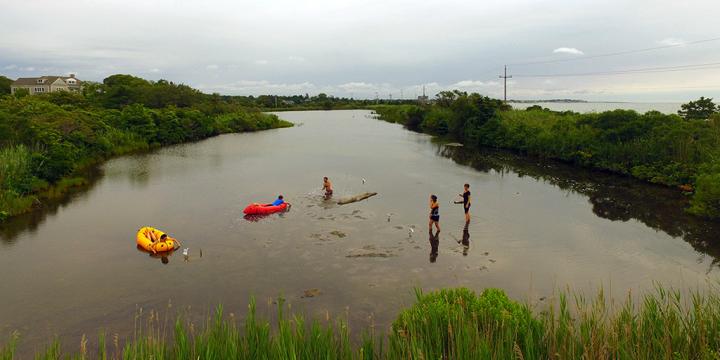
Credit: Rhys Probyn
WOODS HOLE, Mass. — A scientific discovery often starts with a chance observation made by open minds who realize its potential. This happens over and over again in the MBL’s Advanced Research Training courses. A fresh insight leads to a course research project that, after the course is over, can blossom into a full-scale scientific collaboration that continues to connect course participants across the globe.
In 2014, students and faculty in the MBL’s Microbial Diversity course made such a serendipitous observation. A team followed up on it in the coming years and last week, published their insights in the journal Environmental Microbiome.
The story started at Trunk River lagoon, near the Shining Sea Bike Path in Falmouth, Mass., which for decades has been a “natural laboratory” for the Microbial Diversity course along with other local field sites, such as Sippewissett Marsh. (The course, established at MBL in 1971 by Holger Jannasch, will celebrate its 50th anniversary this year).
“A few days after we had waded through the shallow section of Trunk River lagoon, our footprints turned yellow,” says senior author Emil Ruff, a course teaching assistant in 2014-15 and now a scientist in the MBL’s Ecosystems Center and Josephine Bay Paul Center.
Ruff hypothesized that the yellow suspension (which the course participants called microbial “lemonade”) was a sulfur bloom generated by microorganisms that couple photosynthesis to the oxidation of sulfur. The students’ footsteps likely stirred up decaying sea grass and other organic material, releasing sulfide into the water and creating a habitat suitable for rare microbes to bloom.
Blooms of microorganisms are not uncommon in water bodies. Some are so huge that they are visible from satellites. Some are harmful, because they can be toxic for animals, or lead to oxygen depletion in certain areas of the ocean. Blooms generated by high sulfide concentrations are generally a concern, as they can become toxic for fish, mussels and birds. There are many open questions about what triggers bloom formation and collapse.
The next year, Ruff and a team from the Microbial Diversity course returned to Trunk River with the goal of intentionally creating and tracking blooms to study how microbial communities form and change over time. They dug holes in the lagoon and added poles that allowed them to sample daily from several depths without disturbing the water column.
“Often in microbial ecology, we try to understand an ecosystem in its steady state. But it remains unclear how long it takes for an ecosystem to recover after a disturbance and what it takes to establish a diverse [microbial] community,” says Ruff. The experimental design allowed the research team to follow the microbial community as it began to assemble, matured and stratified over time, and collapsed at the end of the bloom.
Understanding these dynamics is particularly important in estuarine ecosystems, such as Trunk River lagoon, that are exposed to natural and human disturbances. Estuaries not only provide important protection from coastal erosion, they also capture carbon from the atmosphere and sequester it. They also serve as a food source and breeding ground for much of the coastal biodiversity.
“The ecology and biogeochemistry causing the sulfur-driven blooms showed us how quickly things can turn, and how ecosystems and microbiomes can rapidly change upon disturbances,” says Ruff.
One surprising finding was where the bloom’s microbes — called anoxygenic phototrophs — found optimal living conditions. Prior to the study, it was generally thought that many of the bloom microbes could not grow in the presence of oxygen. Finding them in mildly oxic waters led the researchers to examine their genomes. They found that certain species of Chlorobiales – the bacterial lineage responsible for most of the bloom biomass and the yellow color — encode enzymes that combat oxygen stress, which could explain the microbes’ oxygen tolerance. This and other insights have already initiated new course research projects.
Like the different functions of the microbes in the Trunk River estuarine community, the Microbial Diversity course brings together teaching fellows, faculty and students with diverse backgrounds and research foci.
“What I found remarkable is the range of expertise in the course,” says Ruff. “You can assemble a group of researchers that can look at all aspects of an ecosystem, including microbiology, physics, chemistry and everything in between. This holistic approach is what the course stands for and passes on to its students each year, for the past 49 years.”
###
Media Contact
Diana Kenney
[email protected]
508-685-3525
Related Journal Article
http://dx.




